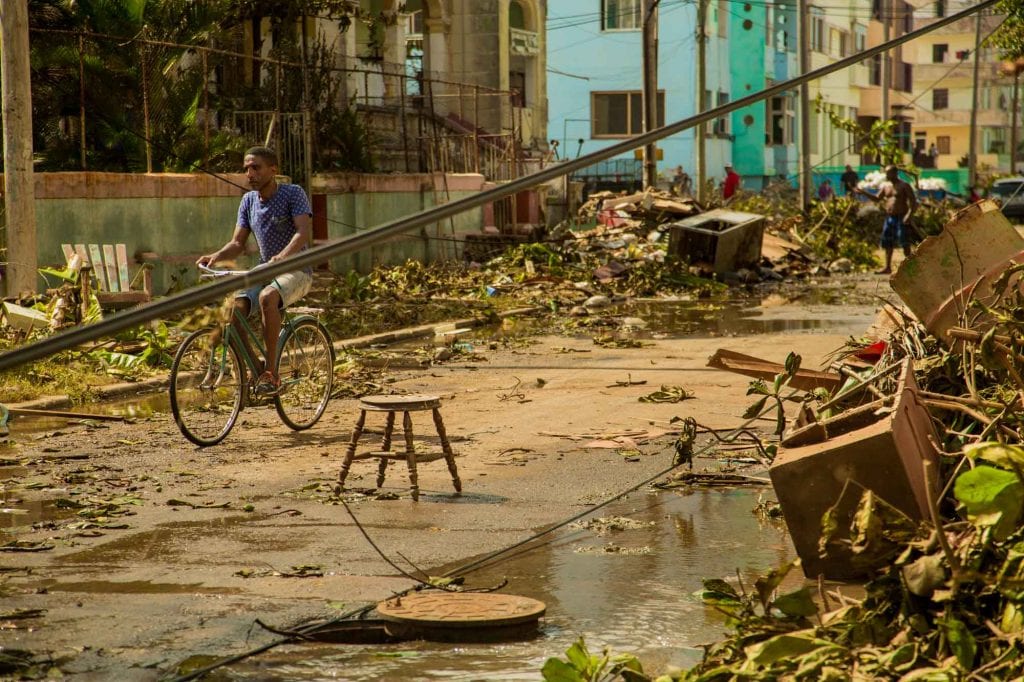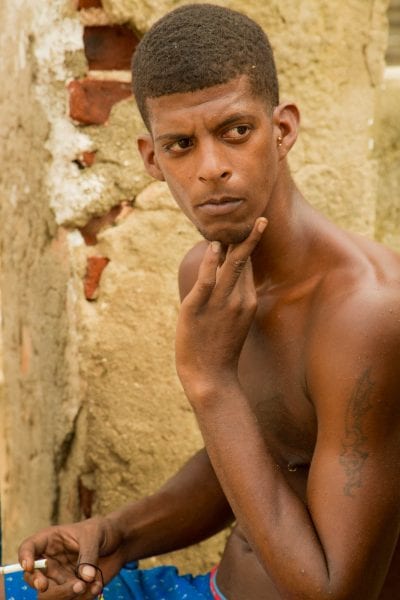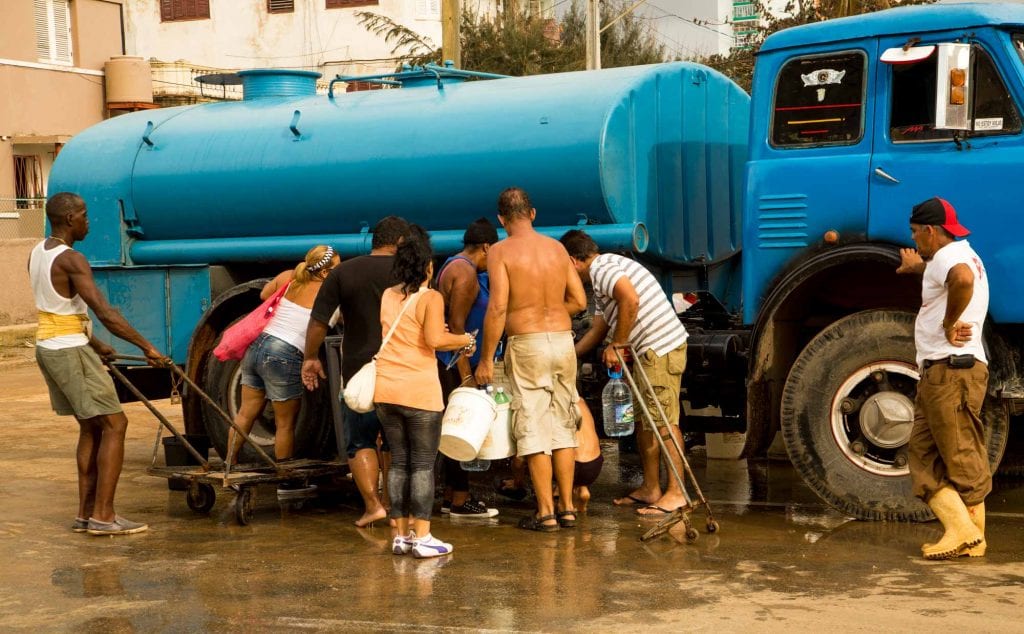The Sea, Hell and a Song
Vedado, Havana on the afternoon of September 11th, based on two jokes.

By Monica Baro (Periodismo de Barrio)
HAVANA TIMES — There are two places in hell: one for the sons of bitches and another one for the really big sons of bitches – Nelson tells me, because of Hurricane Irma, when 48 hours still hadn’t passed by after it swept through Cuba.
Where the sons of bitches go, the shit only reaches your knees, but flying blades pass by once a day and you have to bend down. And where the really big sons of bitches go, the shit reaches up to your neck and you have to learn a song: don’t make waves, don’t make waves, don’t make waves…
Nelson Vega, a resident at No.112 on 3rd avenue, in Havana’s Vedado neighborhood, claims that his jokes used to get a lot more laughs because he used to be a lot funnier. Now, his jokes seem like fables.
Maybe it’s the circumstances we find ourselves in today.
The thing is that they manage to serve Nelson in explaining his philosophy on life, more than anything else, which is the same as explaining why he doesn’t want to move from a place which has flooded three times this year due to sea surges. The two surges beforehand were due to cold fronts and this third one was caused by a hurricane about 140 km away from Havana’s coast.
Nelson says that in life when you don’t have to stick your head down, you have to shout so that waves aren’t made; everything is a question about adapting yourself. Even though he is a metalsmith and not a biologist, he knows that adapting is a necessary condition in order to evolve. And Vedado, the elite neighborhood in the Revolution Square municipality, is where people go to evolve or aspire to evolve.
Why don’t the self-employed open up restaurants in San Miguel del Padron? Nelson asks, almost rhetorically, as if he were asking what color Maceo’s white horse is. Nevertheless, his question is more of an answer to a question which I haven’t made than a question really. He is trying something so obvious like the fact that Maceo’s white horse is white: Vedado is Vedado.
The city’s main theaters, cinemas, hotels, bars, restaurants, institutions, avenues, parks, hospitals, shopping centers etc. are all in the Revolution Square municipality. It’s one of Havana’s most important spots. Therefore, Vedado would be the most important spot within another important spot. Today, it is one of the country’s neighborhoods where prices of housing on the steep Cuban real estate market are the highest.
In exactly the same area where flooding takes place, an apartment with a view of Havana’s Malecon can cost you 150,000 USD and a room costs 150 USD per night in one of these apartments. The sea can be very profitable.
However, the problem is that the actual cost of this housing shouldn’t be taken as an infallible indicator of the people who live there’s buying power. Many of the people who live there have lived there since before these homes took on the value they now have. Other people live in homes that would never take on greater value, because they are garages or retrofitted basements, not actual homes in the first place.
Just like in any other Cuban neighborhood, Vedado is full of contrasts, that is to say, inequalities. And ironically enough, these inequalities are the few things that the sea doesn’t sweep away with its tide, but highlights instead, every time it comes in like a hungry beast to devour the city. And it swallows it.

Streets that become garbage dumps when water levels go down. There are piles and piles of wet garbage. Garbage which is a little more than garbage, because before it was piles of garbage, they were people’s belongings and, therefore, they are now their losses.
Rummaging through this rubbish, through these losses, is like rummaging through people’s lives. You get to learn something about people from their books, shoes, clothes, magazine collections, vinyl albums, windows, radios, music cassettes, armchairs, toilets, paint cans, fans, telephone books, mattresses, wooden shelves, food scraps. You also get to learn something about people from the things they have out drying, even from the way they have put their things out to dry.
On L and 13 Streets, at a garage entrance, a hunched old man hangs out his things on two walls. His belongings are four pairs of slippers, two belts, a quilt, two caps, a stitched bag, a wooden suitcase and a few clothes. When he finishes, he sits down in an iron-cast chair, under the shade of a resistant tree, he lights a cheap cigarette and he sits still watching his things.
Seen from close-up, the old hunched-over man’s things seem to be for sale if looked at from afar, all laid out next to each other. The entire neighborhood could be confused with a Sunday yard sale. Everywhere you look, from L Street to 12 Street and from Linea to the Malecon, but mainly in the blocks nearest to the sea, there are things put out (tied up, hung up, perching, lying down) in a thousand different ways to dry.
The damaged interior worlds of homes, of their residents, are not just put out but are being put on display. Right there, in front of everyone. Without shyness.
There isn’t any privacy for people’s losses or the damage that has been done. Privacy is something else that the sea took away, when people thought that there wasn’t anything left to be taken away. But, nobody seemed to miss it. Mainly because nobody really has it, so nobody acts like they miss it.
They miss more simple things: electricity, drinking water, food and gas. Everything that lets us get back to normal, to continue on with our lives, or whatever “normal” means. Like what usually happens on this island, especially with people who are used to losing things, misfortunes are faced with startling strength. And with a raw and challenging humor, which normally develops into sarcasm.
Nobody stops. Nobody spends time lamenting their fate. Nobody takes delight in terrible things. Nobody cries in the rain. No, because nothing hurts. Everything hurts inside. Because it takes a lot of work, poorly paid work, a lot of “inventing” and sacrifice to buy a decent mattress. We can’t say a home, much less a dignified home.
But, people carry their pain and carry rubble at the same time and take out water and lift tree trunks and their losses and they take out more water and their inside worlds which have become garbage and they take out more water and they sweep and they mop the floor and scrub the grime off of the walls and take out more water and pick up sand and garbage with shovels and they take out more water and they pile up what were their belongings on the street and they still take out more water.
“This is with great pain, outside of the load, the thing is that we’re already used to this craziness, and you await everything with a great attitude, because no matter how much you worry, you won’t be able to stop the sea from coming in,” says Sergio Fernandez, who has lived every one of his 28 years on Quinta and E Streets and knows what having the sea inside your home is ever since he was a little boy.
However, floods are different now. Even though we are used to them, now you feel that they are more intense and horrible than ever. Hurricane Irma’s flooding is the greatest he can remember. Sergio is also a father now. And this time, water levels were over two meters high where he lives with his wife, his son, his mother and four brothers.

Floods aren’t extraordinary events in his life. They are something he talks about without alarm. The pain is there and it will continue on there. Sergio, like so many people, has assumed misfortune with resignation. What else can he do?
He can make a collective caldosa stew which is what he does, in fact. Caldosa cooked by burning firewood, in front of his neighbors’ home. Or at least he helps Carolina, who is the one with the cooking spoon in her hand and is watching the fire. Firewood isn’t the thing in shortage here in the neighborhood. Tonight, on the E St. block between 3rd and 5th avenues, there will be caldosa, rum and dominoes.
Carolina Zamora, who is known in the neighborhood as “Pocholo”, although she prefers to be called Carolina, tells me that they put everything they could collect in the neighborhood into the caldosa: pork meat, bones, cartilage, potatoes, banana, manioc, peppers. Some twenty or thirty neighbors gave what they could.
“The first thing we put in,” she says, “was a big squash which had grown in a sandbank which we cleaned out. We didn’t put in the cat because it ran off.”
Carolina’s home wasn’t affected because it sits on higher ground, but if she is in charge of the caldosa, it’s not because she is one of the most affected. Her explanation is simple and to the point:
“We are all united by the same cause, we all live in the same place.”
Nelson tells me that people in this area used to feel more protected by the State. Trucks used to pass by handing out water to drink and even food. Not anymore.
The first water tanker that Nelson sees come into the neighborhood appears on the corner of 3rd avenue and E street at about 6 PM on September 11th. And, from what it looks like, it’s the first tanker that his neighbors have seen and they all run off to where it has parked, with all kinds of buckets and bottles. Not Nelson. He doesn’t even blink.
He still has water left in his tank. The whole building no. 112 on Tercera avenue does. Because before the electricity was cut, he put on the motor and lifted up the water that was in the cistern to individual tanks on the roof. And people have been saving water. Irma didn’t catch them off their guard. He says that he didn’t go to university for nothing. However, he claims that he would prefer to die of thirst, before running behind a truck with a bucket to collect water.
“I’m not doing that. Because when you go to see, someone can throw you a brick at you for a bucket of water.

Nelson, who became a metalsmith to also adapt to his circumstances, because the truth is he was a teacher and his vocation is to be a teacher, explains that in order to deal with a hurricane and sea surges there are two key things you need to do: be patient and be prepared. The preparation stage is over, now all you can do is be patient.
The garage of his building is still completely flooded and he doesn’t know how much longer it will be. He needs to wait for trucks from the City’s Basic Sanitation services to come. He doesn’t know when electricity, gas and water services will come back either; nor when the piles of garbage will be taken away and when the streets will be cleaned. Nobody knows. But, he clarifies, he doesn’t complain about anything.
“Don’t you know this joke?: I don’t complain about anything here? This is a foreigner who asks a Cuban: “well, what? How do you live here? “Here? Me? Happy, happy. I can’t complain here.” “Well, compadre, if the hurricane came right now and there wasn’t any water.” “Yes, yes, yes, but I can’t complain.” “Compadre, and what about food? Isn’t the food situation bad?” “The food yes, but I’m telling you the truth, I can’t complain… Where the hell are you going to go to complain?”
Everything comes down to the question of adapting. Nelson, Sergio and Carolina know this. When you don’t have to bend down, you have to learn a song.

What a great and emotional read.
Vedado is my home when in Havana. It is because of wonderful people just like these.
The best I’ve read in Havana Times!
Very good article!